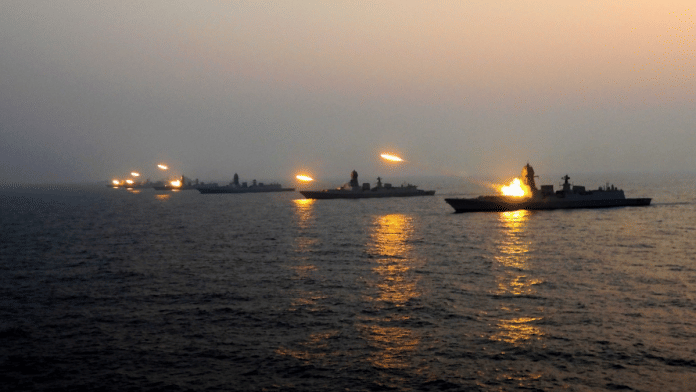New Delhi: INS Tamal, a multi-role stealth guided missile frigate and the last warship to be constructed overseas for the Indian Navy, will be commissioned during a ceremony in Kaliningrad, Russia, on Tuesday.
Once commissioned, the 125 metre long and 3,900 tonne frigate will be deployed with the Navy’s Western Naval Command, which oversees operations in the Arabian Sea and the western Indian Ocean, an area that includes waters near Karachi and along India’s west coast.
Though constructed abroad, INS Tamal features over 26 percent indigenous systems, including the BrahMos supersonic cruise missile capable of striking both land and sea targets.
Among the frigate’s key systems is the ‘SHTIL’ vertical launch air defence system, which includes the vertical launch short-range air-to-air missile (VLSRAAM) and the medium-range surface-to-air missile (MRSAM), both capable of engaging cruise missiles, helicopters, ballistic threats and even sea-and shore-based targets.
The warship is further armed with the ‘A-190-01’ 100 mm naval cannon or naval artillery system that offers improved accuracy and a higher rate of fire compared to its predecessors.
Crafted to Conquer; Engineered to Endure.⚓
Every weld. Every test. Every challenge overcome.
Witness the formidable journey of #INSTamal — from blueprint to battleship.
Commissioning Soon
?️ 01 July 2025#IndianNavy #CombatReady@IndianNavy @IN_WNC @IN_HQENC @IN_HQSNC pic.twitter.com/uqLXbfUWwn
— IN (@IndiannavyMedia) June 28, 2025
For close-range defence, it retains the AK-630 30 mm Close-In Weapon System (CIWS), designed to intercept low-flying threats such as drones and incoming anti-ship missiles. The CIWS can fire at a rate of up to 5,000 rounds per minute, providing a critical last line of defence.
Sources in the Navy said that the guided missile frigate is capable of operating both air early warning and multi-role helicopters, including Kamov-28, which specialises in anti-submarine warfare (ASW), and Kamov-31, designed for airborne early warning (AEW) missions.
They further explained that the ship’s combat capabilities are augmented by a range of network-centric warfare features and a sophisticated electronic warfare suite.
“With a high firepower-to-tonnage ratio, extended operational range and a top speed of over 30 knots, Tamal is expected to offer significant combat capability. Equipped with long-range cruise missiles, the frigate can engage targets at distances of up to 450 kilometres,” one of the sources said.
The vessel features a next-gen electro-optical/infrared (EO/IR) system for better target acquisition and tracking in both day and night operations.
As for anti-submarine warfare, it is armed with heavyweight torpedoes and the RBU-6000 rocket launcher, which can rapidly engage underwater threats. The homegrown HUMSA NG MK-II hull mounted sonar system, developed by the Defence Research and Development Organisation (DRDO) and the Bharat Electronics Limited (BEL), is also integrated with the anti-submarine weapon firing complex.
Complementing its weaponry is a comprehensive set of surveillance, fire-control radars and combat management systems, enhancing the ship’s situational awareness and response capability in multi-domain operations.
A statement by the Navy said that the number of made-in-India systems has more than doubled to 33. “Major Indian OEMs involved in the frigate were BrahMos Aerospace Private Ltd , BEL, Keltron, Nova Integrated Systems from Tata, Elcome Marine, Johnson Controls India and many more,” it said.
Over 250 personnel will operate INS Tamal, having undergone extensive training in St. Petersburg and Kaliningrad. Their preparation included cold-weather trials, high-sea combat simulations and live weapon firing exercises. The frigate has completed a three-month cycle of sea trials, during which its weapons, sensors and onboard systems were rigorously tested and validated.
The Tamal will be the second frigate of the upgraded Tushil class (Project 11356.6), which builds on the capabilities of the earlier Talwar and Teg classes, each comprising three ships.
India and Russia had inked an intergovernmental contract worth Rs 21,000 crore in 2016 to cover the construction of four stealth frigates. INS Tushil and INS Tamal were built at Russia’s Yantar Shipyard in Kaliningrad at a cost of around Rs 8,000 crore. The remaining two (what the Navy refers to as the Triput class) are being constructed at Goa Shipyard Ltd with Russian design support and technology transfer at Rs 13,000 crore.
Once all four ships are commissioned, the Indian Navy will operate a fleet of ten frigates across four closely related classes, ensuring a degree of commonality in weapons, sensors and onboard systems.
(Edited by Tony Rai)






